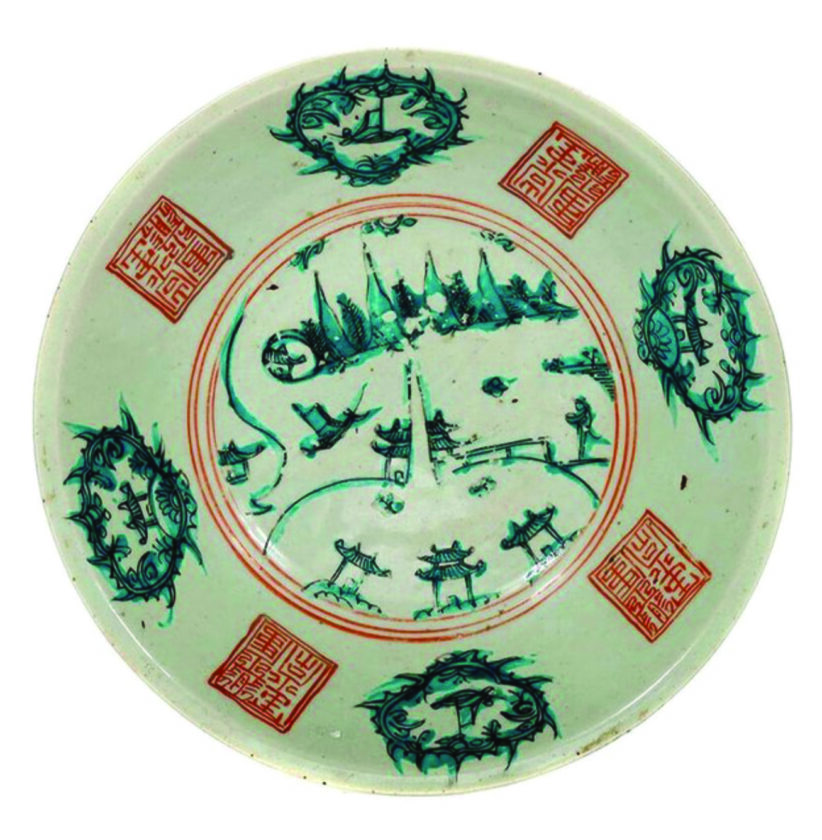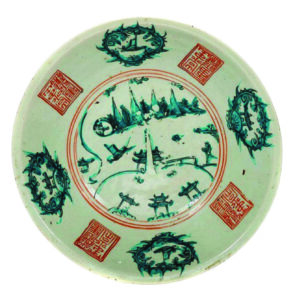Swatow porcelain is highly distinctive

PHOTO PROVIDED
Collectors often categorize types of East Asian porcelain by region or place name. For example, within the broad category of Chinese export porcelains, you have Canton and Nanking, both of which are blue and white with scenic patterns. Swatow porcelain, also named after a port city that exports passed through, may not be quite as popular, but it is more distinctive. It often has a more rustic look than other types of Chinese porcelain, with a coarse texture and gritty base. Designs have a looser, freehand look, and color fields often spread slightly past their outlines. It can be blue and white, but it can also be seen in other colors, like red, green, turquoise, and sometimes yellow. Many designs and patterns exist, including landscapes, animals, and mythical creatures.
The Swatow dish shown here, which sold for $322 at Turner Auctions + Appraisals, has a popular pattern in turquoise and red, with a split pagoda in the center and oval vignettes alternating with blocks of seal script. It dates back to about the 17th century, which was believed to be the peak of Swatow ware production. The script on this dish may be entirely decorative, without an intended meaning. Swatow porcelain was made to export; its prospective buyers were not expected to be able to read Chinese characters. Some known examples have Arabic lettering. Others depict European ships. Designs like those indicate where the pieces were meant to be sold.
Experts consider the name “Swatow ware” a misnomer. Historical and archaeological evidence indicate that the porcelain was made in Zhangzhou, another Chinese port city.
——
Q: I have an old black-and-white photo that my father took when we visited New York City in 1954. It was at a theatre showing King Kong and Abbot and Costello. There is a large King Kong figure outside the theatre. Is it worth anything?
A: It may be. Even if your father isn’t a known photographer, “found photographs” of everyday subjects taken by amateurs have sold as art since the 1990s. You may want to contact an antique dealer in your area. Some antiquarian book dealers buy and sell antique photographs, too. Because of the subject of your photograph, it may also interest movie memorabilia collectors. They would probably give you the best price. Look for a dealer or auction house that sells classic movie posters or other memorabilia.
——
Q: I have an antique sword with a long, thin blade and a small flower on the metal guard on the handle. It has a scabbard with a metal loop. What can you tell me about it? I am looking to sell it for the right price.
A: It sounds like your sword is what collectors call a Russo-Japanese sword, also known as a kyu-gunto. They were Japanese swords used from about 1883 to 1945. The design was based on European sabers, but the flower on the hilt is a Japanese cherry blossom. Officers carried them during the Russo-Japanese War (1904-05) and World War II.
These swords come in many different designs. They had different ornamentation according to an officer’s rank or where the officer was stationed. Blades could be hand forged or machine-made. Scabbards could be made of various materials, including metal, wood, lacquer, or leather. These swords generally sell for about $200-$300, but a high-ranking officer’s sword or one with a very elaborate or distinctive design can sell for thousands of dollars.
For more specific information about yours, like a precise date or what rank it was for, look for the book Swords of Imperial Japan 1868-1945 by Jim Dawson. Military Trader magazine, published by the same company as Kovels Antique Trader, may also have more information. Before you sell your sword, be sure to check your local laws. Some cities and states have strict restrictions on selling any kind of weapon. Look for a dealer or auction house that specializes in military collectibles. World War II reenactors may also be interested in your sword or help you find a buyer.
——
TIP: Maroon and yellowish chrome-green colors were never used to decorate porcelain during the 18th century.
——
Kovels answers readers’ questions sent to the column. Send a letter with one question describing the size, material (glass, pottery) and what you know about the item. Include only two pictures: the object and a closeup of any marks or damage. Be sure your name and return address are included. By sending a question, you give full permission for use in any Kovel product. Names, addresses or email addresses will not be published. We do not guarantee the return of photographs, but if a stamped envelope is included, we will try. Questions that are answered will appear in Kovels Publications. Write to Kovels, (Name of this newspaper), King Features Syndicate, 300 W. 57th Street, 41st Floor, New York, NY 10019, or email us at collectorsgallery@kovels.com

